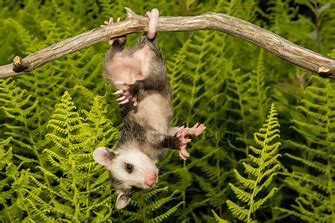By Cathy Baier, Florida Keys SPCA
Little Red Riding Hood’s words—“My, what big teeth you have!”—may come to mind at the shocking sight of a wide-mouth opossum hissing from the bottom of a garbage can or backed into the corner of a garage.

The shelter gets lots of calls about opossums. Sometimes a compassionate caller has concerns about a possum that is injured and is requesting help for the animal. Others call with concerns for the safety of their pets when a possum shows up in the yard. And there are those who simply don’t want a “wild animal” in the neighborhood and want it to be removed regardless. In the Animal Control field, these are referred to as “nuisance wildlife calls” which, in this writer’s opinion, is an unfortunate term.Yes, they can be a problem, and yes, sometimes the situation requires their removal. But not always! The mission of the FKSPCA is to promote a more humane community for all animals. By sharing some of the very unique aspects of opossums, we hope to build greater tolerance and more acceptance, allowing them to coexist with us whenever possible.
To start, opossums and possums are actually two different animals and are biologically different. Opossums live in the Northern Hemisphere, are omnivorous, and have bare tails. Possums are native to Australia and surrounding islands, have bushy tails, and tend to be herbivorous. They look quite different.
Opossums are our only North American marsupial. Babies are called “joeys” and, like kangaroos, begin life in the safety and comfort of their mother’s pouch. As they become too big to fit in the “house” at about 2.5 months, the second chapter of their life begins. At this point and until weaning at 4-5 months, they come out of the pouch and climb onto their mother’s back. It’s quite a sight to see the whole family out searching for food. By 5 months, the little ones are on their own living independently. This is a vulnerable age for them as they are attempting to figure out a life of their own. Opossums have a short lifespan of 1-2 years due to the threat of cars, domestic animals and people.
Domestic animals, especially dogs, are often a bigger threat to opossums than opossums are to them. Cats are a threat to young opossums, but it can be different between adult animals. Adult cats and adult opossums have been seen coexisting, as if the agreement is “You don’t mess with me; I won’t mess with you, and we’ll get along just fine!”
Opossum’s looks don’t serve them well, at least when their appeal is judged by most of us. They can look scary, almost prehistoric. But appearances are often deceiving. These critters are normally quite timid. That scary hiss and open-mouth display is their first line of defense to stay safe from harm. When that fails, they may “play dead”, an involuntary response to stress, almost like fainting. Even more biologically impressive is their ability to emit a scent that mimics death, making themselves even less attractive to predators. Opossums are not aggressive animals by nature. While they certainly can bite, they normally will only bring out their “big guns” (aka teeth), when retreat and passive resistance fail.
Opossums are a benefit to humans in many ways. They are our environmental helpers in keeping things in balance. Scientists have discovered that one opossum can consume 5,000 ticks in a season, preventing tick-borne diseases affecting people and domestic animals. They will eat iguana eggs, which should come as good news to Keys residents! The also eat slugs, snails, roaches, spiders, rodents and even some snakes like rattlesnakes. In fact, it has been discovered that opossums have a built-in immunity to toxic snake venom, making them the subject of study to help create better protection for humans.
In addition to their resistance to certain snake venoms, their naturally low body temperature makes them immune to many diseases affecting other wild animals, most notably rabies. While not impossible, rabies in opossums is very rare.
Every animal, including us, presents some kind of risk somewhere to someone! But despite any perceived or real risk posed by opossums, their unique benefits and special qualities make them worthy of our appreciation and greater tolerance. Next week we will offer practical suggestions on ways to humanely coexist with these wild neighbors and what to do if you discover an opossum has set up camp in your yard or home.
[livemarket market_name="KONK Life LiveMarket" limit=3 category=“” show_signup=0 show_more=0]


No Comment